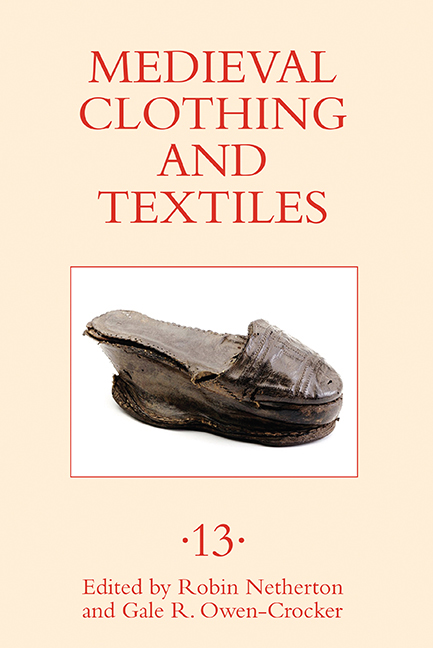Book contents
- Frontmatter
- Contents
- Illustrations
- Tables
- Contributors
- Preface
- 1 The Significance of Dress in the Bayeux Tapestry
- 2 How Long Is a Launce? Units of Measure for Cloth in Late Medieval Britain
- 3 Robes, Turbans, and Beards: “Ethnic Passing” in Decameron 10.9
- 4 Calciamentum: Footwear in Late Medieval Lucca
- 5 “Bene in ordene et bene ornata“: Eleonora d’Aragona’s Description of Her Suite of Rooms in a Roman Palace of the Late Fifteenth Century
- 6 The Lübeck Wappenröcke: Distinctive Style in Fifteenth-Century German Fabric Armor
- Recent Books of Interest
- Contents of Previous Volumes
1 - The Significance of Dress in the Bayeux Tapestry
Published online by Cambridge University Press: 12 August 2020
- Frontmatter
- Contents
- Illustrations
- Tables
- Contributors
- Preface
- 1 The Significance of Dress in the Bayeux Tapestry
- 2 How Long Is a Launce? Units of Measure for Cloth in Late Medieval Britain
- 3 Robes, Turbans, and Beards: “Ethnic Passing” in Decameron 10.9
- 4 Calciamentum: Footwear in Late Medieval Lucca
- 5 “Bene in ordene et bene ornata“: Eleonora d’Aragona’s Description of Her Suite of Rooms in a Roman Palace of the Late Fifteenth Century
- 6 The Lübeck Wappenröcke: Distinctive Style in Fifteenth-Century German Fabric Armor
- Recent Books of Interest
- Contents of Previous Volumes
Summary
Since the embroidered narrative frieze known as the Bayeux Tapestry depicts persons and events of recent history, it is often assumed that its architecture, ships, tools, furniture, and horse tack reflect contemporary eleventh-century life. Not surprisingly, the same assumption is often made of the dress depicted in the embroidery. The clothing in the Tapestry is manifestly different from depictions in Anglo-Saxon art of the garments of Christ, angels, and the four Evangelists Matthew, Mark, Luke, and John, who wear classical dress consisting of tunica and pallium and are generally barefoot. The dress in the Tapestry looks convincingly medieval; but when it is appreciated that some scenes are copied from models in older manuscripts, recognised that there were different artists at work on different parts of the Tapestry, and understood that artwork may show things in “shorthand,” there may be reason to question its authenticity. However, dress is a tool utilised by the Tapestry designer to convey status, gender, and, sometimes, character or demeanour of a historical person. The latter is not always unambiguous for the modern audience. The Tapestry does not exhibit consistent use of colour and details of dress; nor is there consistency of hair colour and depiction of features; apart from the aged King Edward, no figure could be identified solely by appearance. However, it is important to recognise that costume is sometimes manipulated for particular effect.
The ideas in this essay have developed over years, and many of them have appeared as details in earlier publications but have never been brought together in written form before. The result does not claim to be a description of late-eleventh-century dress using the Bayeux Tapestry to demonstrate it, though in some cases the Tapestry may indicate that “fashions” thought to be twelfth-century were already in existence in the eleventh; the essay is rather an examination of what the Bayeux Tapestry shows and a discussion of the choices made by the designer, artists, and embroiderers.
English Male Dress
The knee-length tunic is standard male secular dress in Anglo-Saxon manuscript art of the early eleventh century, such as the Old English illustrated Hexateuch and calendars, and, indeed, in earlier Carolingian art such as the Utrecht Psalter, ca. 800, and there seems no reason to doubt that this represents a garment that was actually worn in early medieval Europe.
- Type
- Chapter
- Information
- Medieval Clothing and Textiles 13 , pp. 1 - 30Publisher: Boydell & BrewerPrint publication year: 2017

